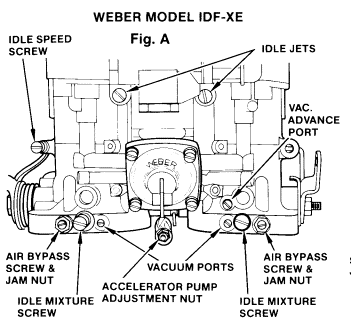IDF CarburetorsLow Speed Circuit Tuning |
|
|
It
is most important to verify all linkage and levers are installed without
binding and the linkage opens to full throttle and is allowed to close to
the Idle Speed Screw. This is the number one and two reasons for tuning
errors, improper linkage installations and over tightened linkage nut,
causing binding in the linkage assembly. The
Individual Runner carbs, IDF, have individual Idle jets and mixture screws
for each barrel. They also have an additional air bleed screws and lock
nuts. This is not used for idle adjustment or idle quality. The
settings for these screws should be closed.
Standard IDF Settings:
Speed
screw ¼ to ½ turn in after contact with lever maximum. Mixture
Screw 1 turn out from lightly seated. “Lean
Best Idle” Procedures After
confirming the linkage allows the throttle lever to seat against the Idle
Speed Screw. Back off the Idle Speed Screw, then turn the screw in until
it contacts the throttle lever and turn it in ½ turn. Turn in the Mixture
Screw in until it “LIGHTLY” seats, then back it out 1 full turn.
Loosen the 8mm wrench size nuts on the “air bleed” screws, turn in the
air screws until it seats then tighten the nut. a.
Start the
engine, it will run slow and like a tractor. As long as it will stay
running, the idle speed is not important at this point. b.
First, turn
in the mixture screw until the engine runs worse, then back out the screw
¼ turn at a time. The engine should start to smooth out. Continue to back
the screw out ¼ turn at a time until the screw does nothing or runs
worse. Then turn it back in to the point where it ran best. You want to
tune the engine by sound. Adjust each mixture screw to the best, fastest
and smoothest running point. Do this procedure with each mixture screw. c.
Now you may
adjust the Idle Speed Screw. It should be sensitive and only require ¼
turn in or out to achieve the idle speed you like. d.
These carbs
are commonly used in pairs, this makes the synchronization important, be
sure to bring the high flowing carb down to the low flow carb. Then bring
them both up to “proper” Idle speed. The Idle Speed Screws are not
opened more than ½ turn in. e.
After
synchronizing multiple carbs, reconfirm steps b. c. & d. “Simple Rules for Calibration”
If
your mixture screw is out more than one turn like 11/2 turns then your
idle jet is too lean, go up one half size on the Idle jet. If
you mixture screw is not out one full turn, something like only 1/2 turn
out from seated then your Idle jet is too rich, go down one half size on
the idle jet. This
is all based on the important fact
that your speed screws are not open
more than ½ turn if they are then that is also an indication that you
have a lean Idle circuit. You
are cheating by opening the throttle plates and exposing additional
progression holes in the transition.
Pump
By-pass Valve: |
|

|
More Tuning & Adjustment 1. Most Critical! Be sure for initial carburetor set up all air by-pass screws should be in closed position. These are not commonly used in standard carburetor adjustment. 2. Set the idle speed screw at ¼ to ½ turn in after contact with throttle lever. When doing multiple carburetors all linkage should be disconnected. All carbs should be bench adjusted to same setting. 3. Set the idle mixture screw to one turn out form lightly seated. When checking the seated position to make only light contact with seat, aggressive seating will damage needle and seat of carburetor, |
|
Adjustment if possible should be to find smoothest idle with each mixture screw on all carburetors. Some prefer to do one barrel of each carburetor then come back and do the second barrel 4. Start engine as long as engine starts and runs do not turn up idle speed first. 5. After preliminary lean best setting of idle. Check carburetors for synchronization. Commonly done by checking lead or front barrel of each carburetor. 6. You will always want to bring high flow carburetor down to match the low flow carburetor. If this cannot be done you will need to recheck bench assembly for binding throttle in high flow carb. Once you have matched both carburetors you will need to set the idle to the desired idle speed setting. This will be done by adjusting both carbs up or down the same amount and re checking for synchronization. 7. Make one last check of lean best (smoothest running position) idle on all mixture screws one last time. 8. Best idle should end up with the mixture screws at or near one turn off seat. Check rule of thumb for idle jet selection on the other side of this page. |
|